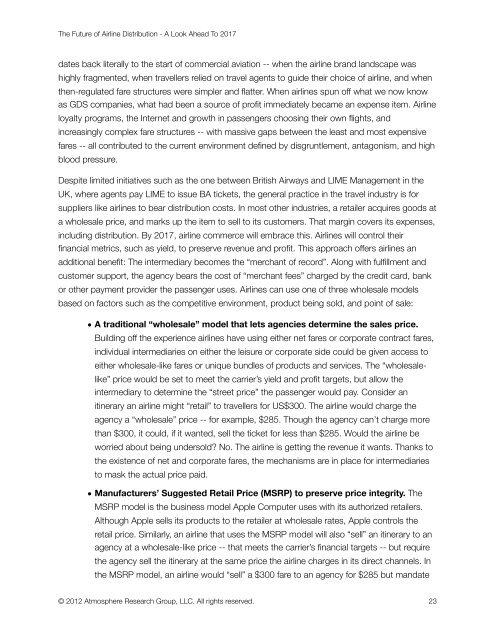The Future Of Airline Distribution - IATA
The Future Of Airline Distribution - IATA
The Future Of Airline Distribution - IATA
You also want an ePaper? Increase the reach of your titles
YUMPU automatically turns print PDFs into web optimized ePapers that Google loves.
<strong>The</strong> <strong>Future</strong> of <strong>Airline</strong> <strong>Distribution</strong> - A Look Ahead To 2017<br />
dates back literally to the start of commercial aviation -- when the airline brand landscape was<br />
highly fragmented, when travellers relied on travel agents to guide their choice of airline, and when<br />
then-regulated fare structures were simpler and flatter. When airlines spun off what we now know<br />
as GDS companies, what had been a source of profit immediately became an expense item. <strong>Airline</strong><br />
loyalty programs, the Internet and growth in passengers choosing their own flights, and<br />
increasingly complex fare structures -- with massive gaps between the least and most expensive<br />
fares -- all contributed to the current environment defined by disgruntlement, antagonism, and high<br />
blood pressure.<br />
Despite limited initiatives such as the one between British Airways and LIME Management in the<br />
UK, where agents pay LIME to issue BA tickets, the general practice in the travel industry is for<br />
suppliers like airlines to bear distribution costs. In most other industries, a retailer acquires goods at<br />
a wholesale price, and marks up the item to sell to its customers. That margin covers its expenses,<br />
including distribution. By 2017, airline commerce will embrace this. <strong>Airline</strong>s will control their<br />
financial metrics, such as yield, to preserve revenue and profit. This approach offers airlines an<br />
additional benefit: <strong>The</strong> intermediary becomes the “merchant of record”. Along with fulfillment and<br />
customer support, the agency bears the cost of “merchant fees” charged by the credit card, bank<br />
or other payment provider the passenger uses. <strong>Airline</strong>s can use one of three wholesale models<br />
based on factors such as the competitive environment, product being sold, and point of sale:<br />
• A traditional “wholesale” model that lets agencies determine the sales price.<br />
Building off the experience airlines have using either net fares or corporate contract fares,<br />
individual intermediaries on either the leisure or corporate side could be given access to<br />
either wholesale-like fares or unique bundles of products and services. <strong>The</strong> “wholesale-<br />
like” price would be set to meet the carrier’s yield and profit targets, but allow the<br />
intermediary to determine the “street price” the passenger would pay. Consider an<br />
itinerary an airline might “retail” to travellers for US$300. <strong>The</strong> airline would charge the<br />
agency a “wholesale” price -- for example, $285. Though the agency can’t charge more<br />
than $300, it could, if it wanted, sell the ticket for less than $285. Would the airline be<br />
worried about being undersold? No. <strong>The</strong> airline is getting the revenue it wants. Thanks to<br />
the existence of net and corporate fares, the mechanisms are in place for intermediaries<br />
to mask the actual price paid.<br />
• Manufacturers’ Suggested Retail Price (MSRP) to preserve price integrity. <strong>The</strong><br />
MSRP model is the business model Apple Computer uses with its authorized retailers.<br />
Although Apple sells its products to the retailer at wholesale rates, Apple controls the<br />
retail price. Similarly, an airline that uses the MSRP model will also “sell” an itinerary to an<br />
agency at a wholesale-like price -- that meets the carrier’s financial targets -- but require<br />
the agency sell the itinerary at the same price the airline charges in its direct channels. In<br />
the MSRP model, an airline would “sell” a $300 fare to an agency for $285 but mandate<br />
© 2012 Atmosphere Research Group, LLC. All rights reserved. 23

















